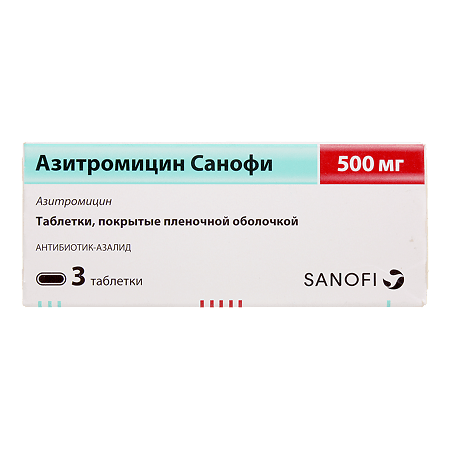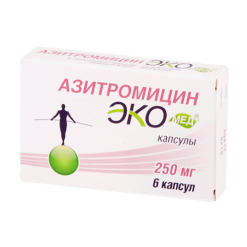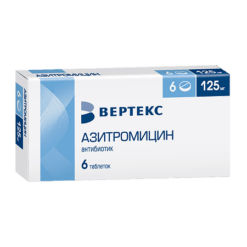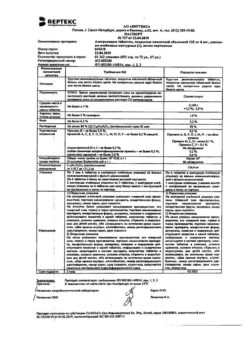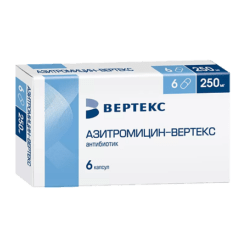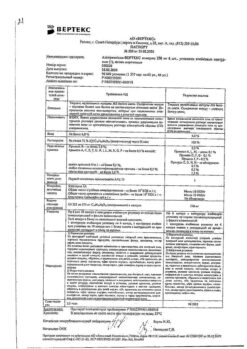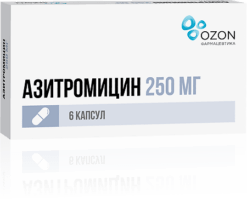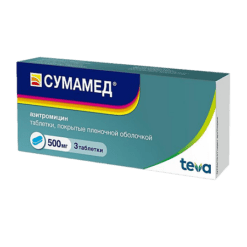No products in the cart.
Sanofi Azithromycin, 500 mg 3 pcs
€1.00
Out of stock
(E-mail when Stock is available)
Description
Pharmacotherapeutic group
Azolid antibiotic
ATX code
J01FA10
Pharmacodynamics:
Asithromycin is a broad-spectrum bacteriostatic antibiotic from the macrolide-azalid group. It has a broad spectrum of antimicrobial action. The mechanism of action of azithromycin is associated with inhibition of microbial cell protein synthesis.
Binding to 50S-subunit of ribosome it inhibits peptide translocase at the translation stage and inhibits protein synthesis, slowing down the growth and reproduction of bacteria. In high concentrations it has bactericidal action.
It has activity against a number of Gram-positive Gram-negative anaerobic intracellular and other microorganisms.
Microorganisms can be initially resistant to the action of the antibiotic or may become resistant to it.
Table 1. Sensitivity scale of microorganisms to azithromycin (minimum inhibitory concentration (MIC) mg/L):
Microorganisms | MIC mg/l | |||
Staphylococcus | | >2 | ||
Streptococcus A B C G | <025 | >05 | ||
S. pneumoniae | <025 | >05 | ||
H. influenzae | <012 | >4 | ||
<05 | >05 | N. gonorrhoeae | <025 | >05 |
Most cases are sensitive to azithromycin:
– Aerobic Gram-positive microorganisms: Staphylococcus aureus (methicillin-sensitive) Streptococcus pneumoniae (penicillin-sensitive) Streptococcus pyogenes Streptococcus group A B C G;
– Aerobic Gram-negative microorganisms: Haemophilus influenzae Haemophilus parainfluenzae Legionella pneumophila Moraxella catarrhalis Pasteurella multocida Neisseria gonorrhoeae;
– anaerobic microorganisms: Clostridium perfringens Fusobacterium spp. Prevotella spp. Porphyromonas spp.;
– other microorganisms: Chlamydia trachomatis Chlamydia pneumoniae Chlamydia psittaci Mycoplasma pneumoniae Mycoplasma hominis Borrelia burgdorferi.
Microorganisms capable of developing resistance to azithromycin:
– Streptococcus pneumoniae (penicillin-resistant).
Microorganisms initially resistant:
– aerobic gram-positive microorganisms: Enterococcus faecalis Staphylococcus spp. (methicillin-resistant staphylococci with a very high frequency of acquired resistance to macrolides);
– erythromycin-resistant Gram-positive bacteria;
– anaerobes: Bacteroides fragilis.Pharmacokinetics:
Azithromycin is well absorbed and rapidly distributed in the body after oral administration. After a single use of 500 mg bioavailability is 37% (first pass effect) maximum concentration in blood (04 mg/l) is achieved after 2-3 hours apparent volume of distribution – 31 l/kg plasma protein binding is inversely proportional to blood concentration and is 7-50%. It penetrates through cell membranes (effective in infections caused by intracellular pathogens). It is transported by phagocytes to the site of infection where it is released in the presence of bacteria. It easily passes the histohematic barriers and enters the tissues. Concentration in tissues and cells is 10-50 times higher than in blood plasma. In the focus of infection it is 24-34% higher than in healthy tissues.
Asithromycin has a very long half-life of 30-50 hours. The tissue elimination half-life is much longer. The therapeutic concentration of azithromycin is maintained up to 5-7 days after the last dose. Azithromycin is mainly excreted unchanged 50% by the intestine 6% by the kidneys. In the liver it is demethylated losing activity.
Indications
Indications
Infectious inflammatory diseases caused by microorganisms sensitive to azithromycin:
– infections of the upper respiratory tract and ENT organs (pharyngitis tonsillitis sinusitis otitis media);
– lower respiratory tract infections (acute bronchitis exacerbation of chronic bronchitis);
– community-acquired pneumonia including.
– Community-acquired pneumonia, including that caused by atypical pathogens (see “Special Indications”).
– infections of the skin and soft tissues (acne vulgaris of moderate severity rye impetigo secondary infectious dermatoses);
– initial stage of Lyme disease (borreliosis) – erythema migrans;
– urinary tract infections caused by Chlamydia trachomatis (urethritis cervicitis).
Active ingredient
Active ingredient
Composition
Composition
Active substance: azithromycin dihydrate (in terms of azithromycin) – 500,000 mg;
Associates: Microcrystalline cellulose, 36,000 mg; lactose monohydrate, 33,464 mg; povidone K-30, 26,000 mg; crosspovidone, 26,000 mg; sodium lauryl sulfate – 1,300 mg; colloidal silicon dioxide – 6,600 mg; magnesium stearate – 6,600 mg;
Film coating:[hypromellose, 12,000 mg, talc, 4,000 mg, titanium dioxide, 2,200 mg, macrogol 4000 (polyethylene glycol 4000), 1,800 mg] or [dry film coating mixture containing hypromellose (60%), talc (20%), titanium dioxide (11%), macrogol 4000 (polyethylene glycol 4000) (9%)] – 20,000 mg.
How to take, the dosage
How to take, the dosage
Inhaled without chewing at least 1 hour before or 2 hours after meals once a day.
Adults and children over 12 years of age with body weight over 45 kg
Infections of the upper and lower respiratory tract ENT organs of the skin and soft tissues: 1 tablet (500 mg) once a day for 3 days (course dose 15 g).
In acne vulgaris of moderate severity: 1 tablet (500 mg) once daily for 3 days then 1 tablet (500 mg) once weekly for 9 weeks (course dose 60 g). The first weekly tablet should be taken 7 days after taking the first daily tablet (8th day from the start of treatment) the next 8 weekly tablets at 7-day intervals.
In Lyme disease (initial stage of borreliosis) – migratory erythema (erythemamigrans): once a day for 5 days: day 1 – 10 g (2 tablets of 500 mg) then from day 2 to day 5 – 05 g (1 tablet of 500 mg) (cumulative dose of 30 g).
Infections of the urogenital tract caused by Chlamydiatrachomatis(urethritis cervicitis): Uncomplicated urethritis/cervicitis – 10 g (2 tablets of 500 mg) once.
Children aged 3 to 12 years with a body weight of less than 45 kg
Infections of the upper and lower respiratory tract ENT organs of the skin and soft tissue: at the rate of 10 mg/kg body weight once a day for 3 days (course dose of 30 mg/kg). For ease of dosing it is recommended to use Table 2.
Table 2. Calculation of Azithromycin dosage for children with body weight less than 45 kg:
Body weight
Amount of azithromycin in tablets
18-30 kg
2 tablets of 125 mg (250 mg azithromycin)
/p>
31-44 kg
3 tablets of 125 mg (375 mg azithromycin)
at least 45 kg
prescribe doses recommended for adults
In pharyngitis/tonsillitis caused by Streptococcus pyogenes, azithromycin is used in a dose of 20 mg/kg/day for 3 days (course dose of 60 mg/kg). The maximum daily dose is 500 mg.
In Lyme disease (initial stage of borreliosis) – migratory erythema (erythemamigrans): 20 mg/kg once daily on the 1st day then at a rate of 10 mg/kg body weight once daily from the 2nd to 5th day. The course dose is 60 mg/kg.
Patients with renal impairment
In patients with mild to moderate renal impairment (CK > 40 ml/min) no dose adjustment is required.
Patients with hepatic impairment
Dose adjustment is not required in mild to moderate hepatic impairment.
Elderly patients
Dose adjustment is not required. Because elderly patients may have current proarrhythmogenic conditions, caution should be exercised when using Azithromycin due to the high risk of cardiac arrhythmias, including pirouette-type arrhythmias.
Interaction
Interaction
Antacids do not affect bioavailability of azithromycin but decrease maximum blood concentrations by 30%; therefore, azithromycin should be taken at least one hour before or two hours after taking these drugs or a meal.
Asithromycin does not affect plasma concentrations of carbamazepine cimetidine didanosine efavirenz fluconazole indinavir midazolam triazolam trimethoprim/sulfamethoxazole cetirizine sildenafil and methylprednisolone when used simultaneously. Concomitant administration of atorvastatin (10 mg daily) and azithromycin (500 mg daily) did not cause changes of atorvastatin concentration in plasma (based on HMK-CoA reductase inhibition test). However, in post-registration period there were separate reports about cases of rhabdomyolysis in patients receiving azithromycin and statins simultaneously.
The concomitant use of azithromycin and rifabutin has no effect on the plasma concentrations of either drug. Neutropenia was sometimes observed when azithromycin and rifabutin were used concomitantly. Although neutropenia has been associated with the use of rifabutin, a causal relationship between the use of a combination of azithromycin and rifabutin and neutropenia has not been established.
In a pharmacokinetic study involving healthy volunteers who received oral azithromycin (500 mg/day once daily) for three days followed by cyclosporine (10 mg/kg/day once daily) a significant increase in maximum plasma concentration and area under the concentration-time curve of cyclosporine was found. Caution should be exercised when concomitant use of these drugs. If concomitant use of these drugs is necessary, it is necessary to monitor the plasma concentration of cyclosporine and adjust the dose accordingly.
Concomitant use of digoxin and azithromycin requires monitoring the plasma concentration of digoxin since many macrolides increase digoxin absorption in the intestine.
If simultaneous use with indirect anticoagulants (such as warfarin or other coumarin-type anticoagulants) is necessary, close monitoring of prothrombin time is recommended.
The concomitant use of terfenadine and macrolide class antibiotics has been found to cause arrhythmias and prolonged QT interval. Therefore, these complications cannot be excluded when terfenadine and azithromycin are taken concomitantly.
The concomitant use of azithromycin (1200 mg) and nelfinavir (750 mg 3 times daily) causes increased equilibrium plasma concentrations of azithromycin. No clinically significant adverse effects have been observed and no dose adjustment of azithromycin with nelfinavir is required.
Asithromycin slightly interacts with cytochrome P450 isoenzymes; there are no known pharmacokinetic interactions similar to those with erythromycin and other macrolides. Azithromycin is neither an inducer nor an inhibitor of cytochrome P450 isoenzymes.
The interaction between azithromycin and theophylline has not been identified.
In concomitant use with zidovudine azithromycin does not affect pharmacokinetic parameters of zidovudine in blood plasma or excretion of it and its metabolite glucuronide by night. However, the concentration of the active metabolite phosphorylated zidovudine in mononuclear cells of peripheral vessels is increased. The clinical significance of this fact is not clear.
The simultaneous use of macrolides with ergotamine and dihydroergotamine may cause their toxic effects.
Persistent use of azithromycin with ergot alkaloid derivatives is not recommended because of the theoretical possibility of ergotism.
Special Instructions
Special Instructions
In case of missing one dose of Azithromycin, the missed dose should be taken as soon as possible and the next ones should be taken 24 hours apart. The preparation Azithromycin should not be used for treatment of pneumonia in patients for whom oral therapy cannot be administered due to the severity of the disease and/or who have the following risk factors: cystic fibrosis, bacteremia or suspected bacteremia, conditions that may change the body’s response to the course of the disease (immunodeficiency, functional asphyxia, etc) patients requiring hospitalization aged or weakened patients. The preparation Azithromycin should be used with caution in patients with liver dysfunction of mild to moderate degree due to possible fulminant hepatitis and severe hepatic insufficiency.
In patients with symptoms of hepatic impairment, such as rapidly increasing asthenia jaundice darkened urine bleeding tendency hepatic encephalopathy, therapy with azithromycin should be discontinued and liver function testing should be performed.
In case of renal dysfunction of mild to moderate degree (CK values over 40 ml/min) the treatment with Azithromycin should be carried out with caution under control of renal function status. In terminal renal failure (CKR less than 10 ml/min) there is a 33 % increase of azithromycin concentration in plasma.
Microbial resistance may develop if the recommended duration of therapy is not followed. As with other antibacterial agents during therapy with Azithromycin, patients should be regularly monitored for the presence of immune microorganisms and for signs of superinfections, including fungal ones.
Asithromycin should not be used over a longer course than directed, since the pharmacokinetic properties of azithromycin suggest a short and simple dosing regimen.
Penicillin is usually the drug of choice for prophylaxis of pharyngitis/tonsillitis caused by Streptococcus pyogenes and also for prevention of acute rheumatic fever.
Azithromycin may cause pseudomembranous colitis caused by Clostridiumdifficile both as mild diarrhea and severe colitis when prolonged use. Clostridium pseudomembranous colitis should be excluded if diarrhea develops during treatment with Azithromycin, as well as 2 months after discontinuation of therapy. The use of drugs inhibiting intestinal peristalsis is contraindicated. Delayed ventricular repolarization syndrome – QT interval prolongation syndrome – increases the risk of arrhythmias, including “pirouette”-type arrhythmias during macrolide therapy and also azithromycin. Caution should be exercised when using azithromycin in patients with prolonged QT receiving therapy with antiarrhythmic agents of class IA III cisapride if hypokalemia or hypomagnesemia is clinically significant arrhythmia bradycardia or severe heart failure.
We should use caution when using azithromycin concomitantly with antipsychotic drugs (pimozide) antidepressants (citalopram) fluoroquinolones (moxifloxacin levofloxacin) cyclosporine and in elderly patients.
The use of the drug Azithromycin may provoke myasthenic syndrome or cause exacerbation of myasthenia gravis.
The effect on the ability to drive:
With the development of adverse effects on the nervous system and the visual system, caution should be exercised when performing activities requiring increased concentration and rapid psychomotor reactions.
Synopsis
Synopsis
Contraindications
Contraindications
– hypersensitivity to azithromycin erythromycin other ketolide macrolides or other components of the drug;
– severe hepatic impairment;
– severe renal impairment (creatinine clearance (CK) less than 40 ml/min);
– children under 12 years of age with body weight less than 45 kg (for 500 mg tablets);
– children under 3 years of age (for 125 mg tablets);
– breastfeeding period;
– concomitant administration with ergotamine and dihydroergotamine;
– lactose intolerance glucose-galactose malabsorption.
With caution:
Pregnancy; myasthenia gravis; mild to moderate hepatic dysfunction; mild to moderate renal dysfunction (CK greater than 40 ml/min); elderly patients; in patients with proarrhythmogenic factors (especially elderly patients): with congenital or acquired prolongation of the QT interval in patients receiving therapy with antiarrhythmic drugs of class IA (quinidine procainamide) III (dofetilide amiodarone and sotalol) cisapride terfenadine antipsychotic drugs (pimozide) antidepressants (citalopram) fluoroquinolones (moxifloxacin levofloxacin) with disorders of water andelectrolyte balance especially in case of hypokalemia or hypomagnesemia with clinically significant bradycardia, cardiac arrhythmia or severe heart failure; concomitant use of digoxin warfarin cyclosporine.
Side effects
Side effects
The frequency of side effects is classified according to the World Health Organization recommendations: very often, at least 10%; often, at least 1% but less than 10%; infrequently, at least 01% but less than 1%; rarely, at least 001% but less than 01%; very rarely, less than 001% (including isolated cases).
Infectious diseases:
frequent – candidiasis including oral and genital mucosa;
very rare – pseudomembranous colitis.
Metabolism and nutrition: often – anorexia.
Allergic reactions:
frequently – skin itching skin rash;
infrequently – hypersensitivity reactions photosensitization reaction urticaria Stevens-Johnson syndrome angioedema;
very rarely – anaphylactic reaction erythema multiforme toxic epidermal necrolysis.
Blood and lymphatic system disorders:
frequent – eosinophilia lymphopenia;
infrequent – leukopenia neutropenia;
very rarely – thrombocytopenia hemolytic anemia.
In the respiratory system:
infrequent – pneumonia pharyngitis respiratory diseases rhinitis dyspnea nasal bleeding.
Nervous system disorders:
frequent – headache dizziness paresthesia impaired sense of taste; infrequenthypoesthesia drowsiness insomnia nervousness;
frequently – agitation;
very rarely –
Overdose
Overdose
Similarities
Similarities
Additional information
| Shelf life | 3 years. Do not use after the expiration date. |
|---|---|
| Conditions of storage | Store in a light-protected place at a temperature not exceeding 25°C. Keep out of reach of children |
| Manufacturer | Zentiva k.s., Czech Republic |
| Medication form | pills |
| Brand | Zentiva k.s. |
Other forms…
Related products
Buy Sanofi Azithromycin, 500 mg 3 pcs with delivery to USA, UK, Europe and over 120 other countries.

